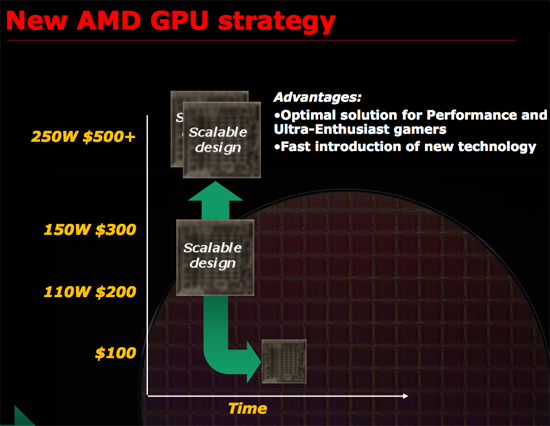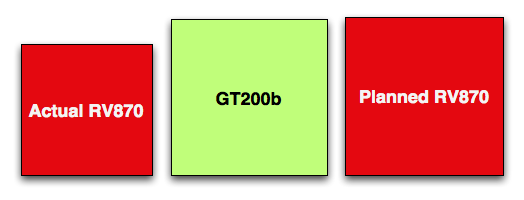The RV870 Story: AMD Showing up to the Fight
by Anand Lal Shimpi on February 14, 2010 12:00 AM EST- Posted in
- GPUs
The Other Train - Building a Huge RV870
While the Radeon HD 5800 series just launched last September, discussions of what the GPUs would be started back in 2006.
Going into the fall of 2007 ATI had a rough outline of what the Evergreen family was going to look like. ATI was pretty well aware of DirectX 11 and Microsoft’s schedule for Windows 7. They didn’t know the exact day it would come out, but ATI knew when to prepare for. This was going to be another one of those market bulges that they had to align themselves with. Evergreen had to be ready by Q3 2009, but what would it look like?
Carrell wanted another RV770. He believed in the design he proposed earlier, he wanted something svelte and affordable. The problem, as I mentioned earlier, was RV770 had no credibility internally. This was 2007, RV770 didn’t hit until a year later and even up to the first day reviews went live there were skeptics within ATI.
Marketing didn’t like the idea of building another RV770. No one in the press liked R600 and ATI was coming under serious fire. It didn’t help that AMD had just acquired ATI and the CPU business was struggling as well. Someone had to start making money. Ultimately, marketing didn’t want to be on the hook two generations in a row for not being at the absolute top.
It’s difficult to put PR spin on why you’re not the fastest, especially in a market that traditionally rewards the kingpin. Marketing didn’t want another RV770, they wanted an NVIDIA killer. At the time, no one knew that the 770 would be an NVIDIA killer. They thought they just needed to build something huge.

AMD's new GPU strategy...but only for the RV770
From August through November 2007, Carrell Killebrew came very close to quitting. The argument to build a huge RV870 because NVIDIA was going to build a huge competitor infuriated him. It was the exact thinking he fought so hard against just a year earlier with the RV770. One sign of a great leader is someone who genuinely believes in himself. Carrell believed his RV770 strategy was right. And everyone else was trying to get him to admit he was wrong, before the RV770 ever saw the light of day.
Even Rick Bergman, a supporter of Carrell’s in the 770 design discussions, agreed that it might make sense to build something a bit more aggressive with 870. It might not be such a bad idea for ATI to pop their heads up every now and then. Surprise NVIDIA with RV670, 770 and then build a huge chip with 870.
While today we know that the smaller die strategy worked, ATI was actually doing the sensible thing by not making another RV770. If you’re already taking a huge risk, is there any sense in taking another one? Or do you hedge your bets? Doing the former is considered juvenile, the latter - levelheaded.
Carrell didn’t buy into it. But his options were limited. He could either quit, or shut up and let the chips fall where they may.

A comparison of die sizes - to scale.
What resulted was sort of a lame compromise. The final PRS was left without a die size spec. Carrell agreed to make the RV870 at least 2x the performance of what they were expecting to get out of the RV770. I call it a lame compromise because engineering took that as a green light to build a big chip. They were ready to build something at least 20mm on a side, probably 22mm after feature creep.










132 Comments
View All Comments
Dudler - Sunday, February 14, 2010 - link
Whoa... Just Whoa.Very insightful and interesting.
Amd moving to GF next generation and Norther Islands this year?
Whoa.
Thx Anand :)
carlhenry - Sunday, February 14, 2010 - link
i really loved the eyefinity being so 'mission impossible'. awesome article!Patrick Wolf - Sunday, February 14, 2010 - link
The first rule of SunSpot: You don't talk about SunSpot. :Dmubeen - Tuesday, February 16, 2010 - link
Such an informative article Mr. Anand. Really appreciate your efforts.just4U - Tuesday, February 16, 2010 - link
I agree it's a great article, nice to see these ones pop up from time to time. It don't really matter to me if it's nvidia, amd or intel.. just having a more insightful read is refreshing.DearSX - Sunday, February 14, 2010 - link
I really do a like article like this. I wonder how old others are cause I'm 25 and I did not even notice how much reading things like this mattered. Its more important than buying something or performance figures imo.Paulman - Sunday, February 14, 2010 - link
I, too, will second that. Really cool. :PMrSpadge - Sunday, February 14, 2010 - link
Many thanks for this interesting article and especially the in-dpeth information about TSMC, the process and how ATI deals with it. Thanks to you, Anand, for writing it and thanks to the good guys at AMD for sharing this information!Beyond excellence :)
hyvonen - Monday, February 15, 2010 - link
And NVidia's call for "zero defects, zero variability" was jaw-dropping. Do they have any idea how silicon is manufactured?Unbelievable cluelessness... with this attitude, they are out of business in the next two years. They are completely unprepared to harness the potential in the latest process nodes.
Meanwhile, it also sounds like TSMC is way over its head in this - uncharacteristic screw-ups with the chamber matching, bad leakage etc. Not to mention the choice to delay HKMG until 28nm (and having to kill 32nm because of that). GF is going to eat them for lunch, and take over the foundry business.
ET - Sunday, February 14, 2010 - link
Indeed. One of the more interesting articles I've read in a while.